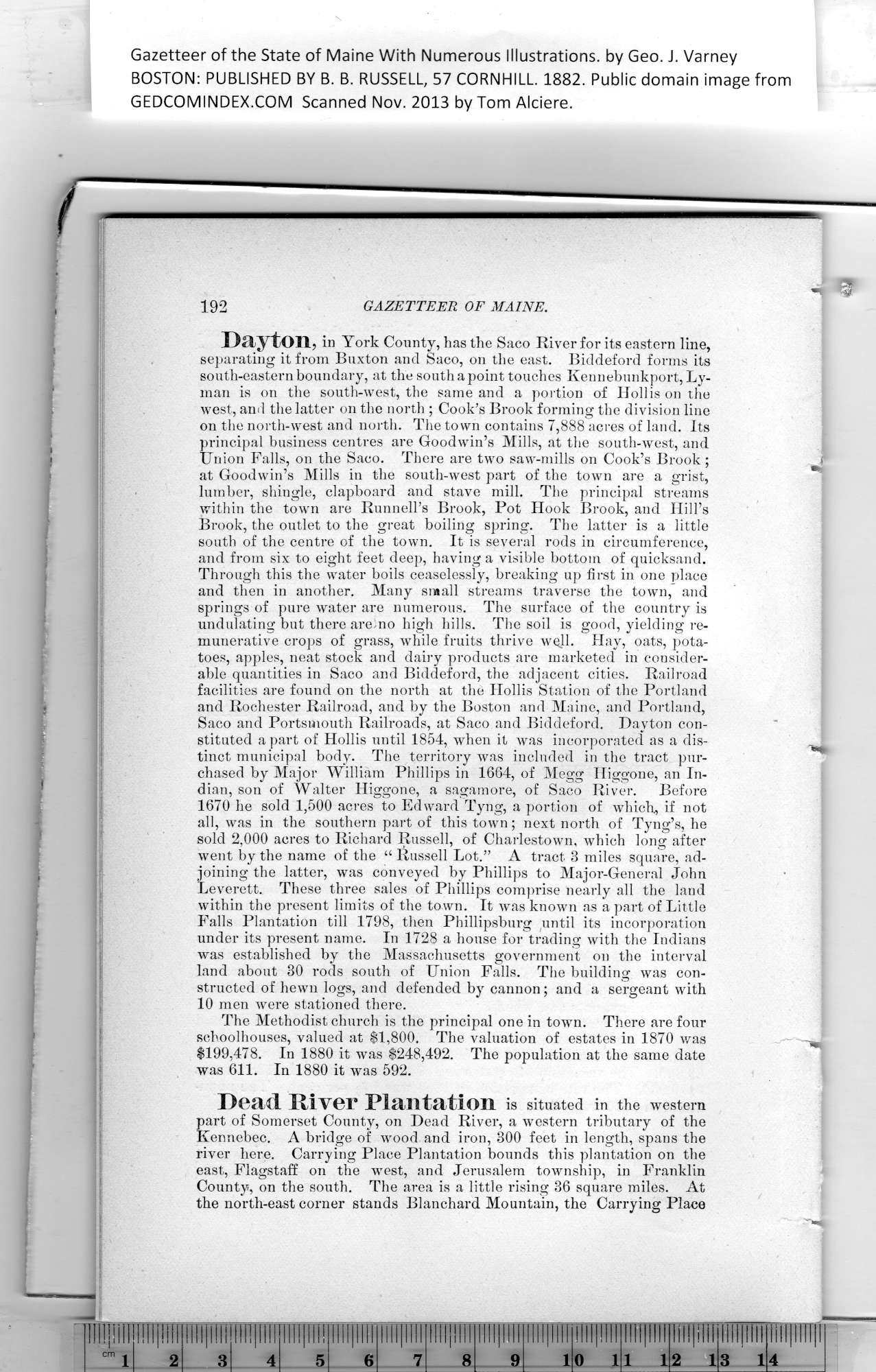|
Gazetteer of the State of Maine With Numerous Illustrations, by Geo. J. Varney
BOSTON: PUBLISHED BY B. B. RUSSELL, 57 CORNHILL. 1882. Public domain image from
192 GAZETTEER OF MAINE.
Dayton, in York County, has the Saco River for its eastern line,
separating it from Buxton and Saco, on the east. Biddeford forms its
south-eastern boundary, at the south a point touches Kennebunkport, Ly-
man is on the south-west, the same and a portion of ITollis on the
west, and the latter on the north ; Cook’s Brook forming the division line
on the north-west and north. The town contains 7,888 acres of land. Its
pi’incipal business centres are Goodwin’s Mills, at the south-west, and
Union Falls, on the Saco. There are two saw-mills on Cook’s Brook ;
at Goodwin’s Mills in the south-west part of the town are a grist,
lumber, shingle, clapboard and stave mill. The principal streams
within the town are Runnell’s Brook, Pot Hook Brook, and Hill’s
Brook, the outlet to the great boiling spring. The latter is a little
south of the centre of the town. It is several rods in circumference,
and from six to eight feet deep, having a visible bottom of quicksand.
Through this the water boils ceaselessly, breaking up first in one place
and then in another. Many small streams traverse the town, and
springs of pure water are numerous. The surface of the country is
undulating but there are.no high hills. The soil is good, yielding re-
munerative crops of grass, while fruits thrive well. Hay, oats, pota-
toes, apples, neat stock and dairy products are marketed in consider-
able quantities in Saco and Biddeford, the adjacent cities. Railroad
facilities are found on the north at the Hollis Station of the Portland
and Rochester Railroad, and by the Boston and Maine, and Portland,
Saco and Portsmouth Railroads, at Saco and Biddeford. Dayton con-
stituted apart of Hollis until 1854, when it was incorporated as a dis-
tinct municipal body. The territory was included in the tract pur-
chased by Major William Phillips in 1664, of Megg Higgone, an In-
dian, son of Walter Higgone, a sagamore, of Saco River. Before
1670 he sold 1,500 acres to Edward Tyng, a portion of which, if not
all, was in the southern part of this town; next north of Tyng’s, he
sold 2,000 acres to Richard Russell, of Charlestown, which long after
went by the name of the “ Russell Lot.” A tract 3 miles square, ad-
joining the latter, was conveyed by Phillips to Major-General John
Leverett. These three sales of Phillips comprise nearly all the land
within the present limits of the town. It was known as a part of Little
Falls Plantation till 1798, then Phillipsburg until its incorporation
under its present name. In 1728 a house for trading with the Indians
was established by the Massachusetts government on the interval
land about 30 rods south of Union Falls. The building was con-
structed of hewn logs, and defended by cannon; and a sergeant with
10 men were stationed there.
The Methodist church is the principal one in town. There are four
schoolhouses, valued at $1,800. The valuation of estates in 1870 was
$199,478. In 1880 it was $248,492. The population at the same date
was 611. In 1880 it was 592.
Dead River Plantation is situated in the western
part of Somerset County, on Dead River, a western tributary of the
Kennebec. A bridge of wood and iron, 300 feet in length, spans the
river here. Carrying Place Plantation bounds this plantation on the
east, Flagstaff on the west, and Jerusalem township, in Franklin
County, on the south. The area is a little rising 36 square miles. At
the north-east corner stands Blanchard Mountain, the Carrying Place
PREVIOUS PAGE ... NEXT PAGE
This page was written in HTML using a program written in Python 3.2
|
